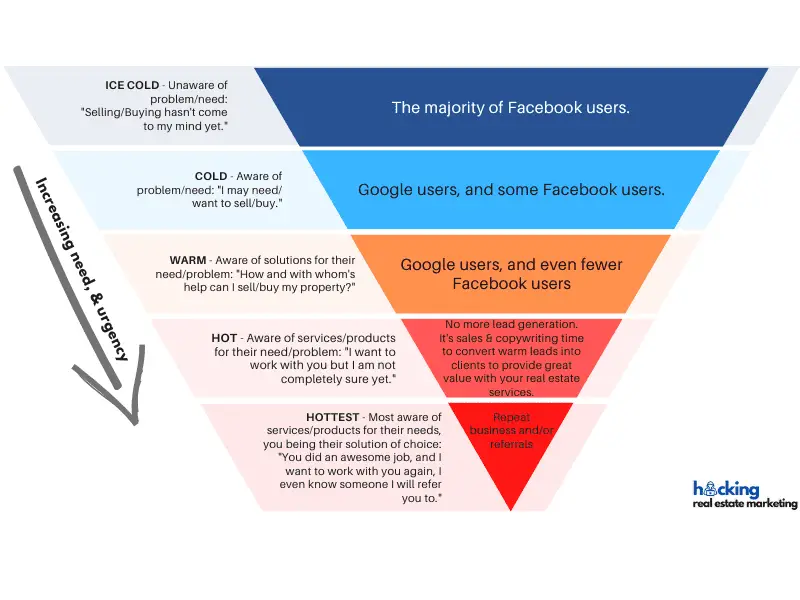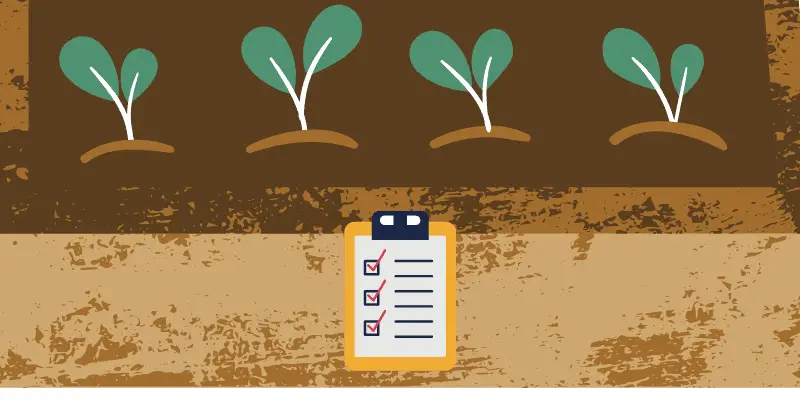Real estate farming is often misunderstood and only reduced to geographic farming.
Many different tactics are floating around on the web; some are better ordered, and some less.
And suppose you just throw these tactics one after another against the wall like spaghetti waiting for them to work without aligning them with your goals and thinking it through.
In that case, you may waste precious time and money.
So, in this article that you can consider a short and sweet real estate farming strategy guide, I will cover…
- How to do real estate farming
- How to work out a real estate farming strategy in eight steps
- And explain that these strategies actually don’t differ from general real estate marketing strategies.
How to Do Farming in Real Estate?
In (real estate) marketing and lead generation, many things that follow evergreen principles get fancy names and are “sold” as something new or different.
But actually, they aren’t.
This is the case with real estate farming.
So, when you wonder how to do farming in real estate, it’s almost the same question as asking how to do real estate marketing and lead generation.
In my article “What is Real Estate Farming & Does it Really Work?” I explained real estate farming the following way:
“Real estate farming is the label of a particular marketing strategy for lead generation.
The main characteristic is focusing on a specific target group with your chosen lead generation method.
Ideally, selecting the target group informs your lead generation method and messaging (e.g., the sales copy).”
And in the traditional way of doing real estate farming, the specific target group happens to have the common denominator of living in a particular geographic area.
That’s all, but it’s nothing special.
Finding, analyzing, and targeting a specific group of prospects is what you should ideally do in (real estate) marketing and lead generation anyways.
To find out how to do real estate farming, we can use my answer of whether it works as a basis.
I discussed this topic in this article I wrote a few weeks back.
Unfortunately, this question can’t be answered with a straightforward “yes” or “no” since the answers depend on various factors.
Still, they provide a basis for a real estate farming plan or strategy.
Working Out a Real Estate Farming Strategy and Plan [8 Steps]
In real estate farming, you are not limited to a particular type of lead generation method or marketing channel.
Ideally, you focus on the lead generation method where the group of buyer or seller prospects can best be reached.
The latter also informs the messaging, including the sales copy you want to use.
So finally, working out a real estate farming strategy and plan is pretty similar if not the same as working out a real estate marketing plan (my article), as you will see in the following eight steps:
Step 1 – Your Goals
Determine your annual commission goal after taxes and commission splits, and based on that, the gross commission and the number of transactions you need to make.
Step 2 – Your Time Frame to Reach Your Goals
Determine the time frame in which you want to reach your annual commission goal.
This time frame will also inform what type of leads you need to target and whether you need a higher or lower monthly marketing (farming) budget.
Step 3 – Selecting the Right Target Group (Including their Awareness Stage)
Based on steps one and two, you want to determine the group of prospects you want to focus on.
For example, suppose you want to reach a sporty commission goal within 12 months.
In that case, it will make little sense to focus on a target group of lead types who are problem and need unaware (see my article on real estate lead types here).
Sending direct mail to FSBOs (rather problem and need-unaware) instead of divorce leads (problem and need-aware) wouldn’t be helpful for the same reason.
Why?
The first group of prospects will take much longer to get from the unawareness of the problem and need awareness level (see my infographic about customer awareness levels below).

This would collide with the time frame of 12 months to reach the commission income goal.
Here you also decide if you go the traditional route of geographic real estate farming, focusing on a particular neighborhood, or if you slice your target group according to other or additional demographic criteria and real estate niches.
Generally, the more targeted you get, the better the lead quality.
Why?
Because you can better tailor your messaging (sales copy) to the target group.
This leads me to the next step…
Step 4 – Prospect Awareness – Message – Match
You select the best-suited marketing channel based on what you determined in step three.
Is your target group defined around a particular geographic area, and, at the same time, are baby boomers?
In that case, direct mail may indeed be suitable.
And you will need to tailor your marketing message (sales copy) to their problem and need awareness level.
The better you can match the sales copy to the respective awareness stage (see infographic above) of the prospects you are targeting, the better your conversion rates will be.
Step 5 – The Right Geographic Area of Focus
Also, based on steps one and two, and if you focus on geographic real estate farming, determine your geographic area of focus based on the turnover rate.
Again, if your time frame to reach your commission income goal is rather short (e.g., 12 months), a neighborhood with a low turnover rate will not be helpful.
Step 6 – Determine the Viability of Your Real Estate Farming/Marketing Strategy Based on Your Monthly Marketing Budget
You also need to find out if the chosen lead generation methods are viable from the point of view of your monthly marketing budget.
Everything may look right based on the above, but to reach the commission income goal within 12 months, you may need a monthly budget of $2,000 instead of the $500 you currently have.
In that case, it’s not a viable goal, or at least not in your intended time frame.
Step 7 – Optimizing and Iterating Your Marketing Campaigns
A plan for optimizing and iterating your lead generation campaigns should also be part of your real estate (farming) strategy.
It’s a myth that you can just run a fresh and new campaign and have a winner from the get-go.
All campaigns can be improved over time with the right testing and optimizing protocol, so you generate more and better quality leads.
How fast you can iterate different versions of a real estate lead generation campaign also highly depends on step six, your monthly budget.
And the earlier you want to reach your commission income goals, the faster you need to be able to iterate.
And how well you can optimize and iterate also depends on how well you can track the campaign performance with key marketing performance indicators.
Step 8 – A Plan for Real Estate Lead Nurturing
Again, real estate lead nurturing is nothing exclusive to real estate farming.
However, many articles on real estate farming insinuate lead nurturing is unique to real estate farming.
Why is that?
Probably, because you “cultivate” something (the leads) to stay within the farming metaphor and then convert them into customers.
But all lead generation needs also lead nurturing, so you get a better ROI for your marketing campaigns.
So, step eight is preparing a plan to nurture the real estate leads you generate.
The critical thing to remember here is to consider the prospect awareness-message-match in your lead nurturing campaigns as you should in your lead generation campaigns.
You may also be interested in this article in the context of lead nurturing.
So, when you look at all these steps again, you may come to the same conclusion as me.
“Real estate farming” is only a label of a real estate marketing strategy for lead generation, and focusing on a specific target group is the main characteristic.
And yes, the common denominator of the target group can be a particular geographic area (geographic real estate farming).
By the way, I wrote about the other types of real estate farming in this article.
The latter is what most real estate farming information on the web focuses on. So you usually find less strategic, and more than anything else, tactical tips for this type of real estate farming, such as…
- Targeting the right neighborhood
- Using 4″ to 6″ postcards in direct mailing to stand out
- Delivering value to your farm (timing)
- Planning the management and tracking of leads
- Start a Facebook group for your local community
- Attending meetings in your area (e.g., city and county)
- Hosting community events
- Emailing updates about your market to your farming community
- Using neighborhood hashtags
- Use promotional products such as swag bags
- Target FSBOs and expired listings
- Host open houses
- Always get email addresses
- Taking neighborhood walks
The above are all well-meaning tips.
However, they are, again, more than anything else, tactical and not strategic for trying to achieve a particular goal (e.g., a commission income goal).
For example, let’s just pick attending county meetings.
If you have an ambitious income goal to increase your transactions by 50% within twelve months, you would be ill-advised to attend them, or at least you should not prioritize them too high.
Why?
Because it’s a long-term lead gen strategy. The likelihood of meeting problem and need-aware prospects is slim.
And you will need problem and need-aware prospects for the goal mentioned above.
Why?
You want to have the needed number of transactions not in one to two years from now but in a few months.
Yes, some seller or buyer prospects attending such a meeting may need to sell or buy urgently.
But there are more effective ways to generate and specifically target these leads.
Sure, you can still attend these events while having the above goal. #
Still, they should get a lower priority than other lead generation methods in that case.
That’s why it can be risky to just start playing around with one or more of the above tactical tips without thinking them through beforehand.
You may end up focusing on the wrong “farming” activities.
This article has been reviewed by our editorial team. It has been approved for publication in accordance with our editorial policy.
- Performance Risks of “Marketing ROI Black Boxes” for Real Estate and other Industries - October 15, 2024
- What You Don’t Measure in Real Estate Marketing… - October 1, 2024
- What a Worn-Out Flight Attendant Has to Do with Your Real Estate Lead Gen ROI - September 17, 2024

